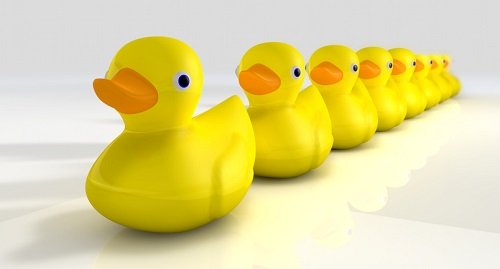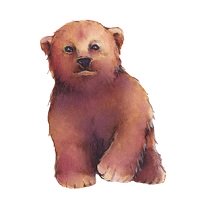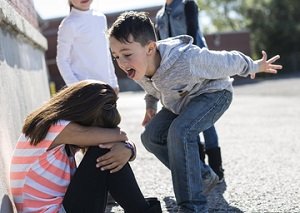When does peer pressure start? Early. Very early in life.
© 2022 Gwen Dewar, all rights reserved

Peer pressure and social conformity starts long earlier adolescence. When faced with a choice between telling the truth and backing a popular falsehood, fifty-fifty four-twelvemonth-old children will buckle.
You and three other people are sitting in next booths, and you've each got a re-create of the same book.
Open to the first page. Y'all see a motion-picture show of a family unit of bears. On the next folio, y'all see a picture of simplyone fellow member of that family unit.
At present suppose I inquire y'all to tell me who's featured in the solo picture show.

Is it Papa Carry? Mama Deport? Infant Bear? You've heard the other people claim that the character is Papa Carry. But you see very conspicuously that it'sBaby Conduct.What do you say?
It probably depends on a lot of things. Your motivation, your confidence, the social context. Does information technology really matter what you say? Is your answer going to be public? Practice you live in a civilization that puts a premium on plumbing equipment in?
And what nearly your age? Nosotros know that many adults are inclined to give into social force per unit area. Merely how early does this tendency sally? When does it beginning?
Y'all might be thinking of adolescence. Only try again. Researchers have documented the phenomenon among trivial kids.
One of the breakthrough studies was conducted at the Max Planck Found for Evolutionary Anthropology, where psychologists Daniel Haun and Michael Tomasello performed this "Babe Comport" examination on iv-year-olds.
The researchers had children sit in groups of 4, with each child in a private berth that allowed him or her to hear, only not see, the other kids. The children were given picture books they believed to be identical. Simply in fact, ane in four books varied.Some of the pictures were different.

The exam went similar this: Kids were asked to turn to the correct folio in their books, and and then, one at a fourth dimension, asked to study what they saw.
There were 18 trials in all. In 12 trials, the books all showed the same images. In the other six trials, the images differed and the child in possession of the odd volume faced a conflict. Study what you see, or get forth with the crowd.
In total, 96 kids participated. Twenty four of them were randomly selected to receive the odd book. And eighteen out of 24 of these children conformed to the (inaccurate) majority opinion at least once. Ten kids did it on nigh trials.
Sit down a kid downwards with iii other preschoolers, and she might decide to agree that it's Papa Acquit, when she really knows information technology'south Baby Bear.

To check, Haun and Tomasello ran a 2d experiment in which kids were sometimes permitted to answer the question privately (then the other kids wouldn't know).
In those cases, kids still occasionally changed their answers to adapt. But not equally much.
Children were most likely to conform when they knew other people were listening.
And then it seems this really was well-nigh peer pressure level — about going with the catamenia.
What exactly are children thinking when they make these decisions?
That isn't clear. Maybe kids are just applying lessons learned by trial-and-error. They've gotten into conflicts with other kids before. They've learned that they get into less trouble when they conform.
Or perhaps, propose Haun and Tomasello, something more sophisticated is going on. Kids are thinking about how other people see them. They are consciously grooming a public image.
Either way, nosotros've got evidence that young children are trying to fit in. Even when that means paying lip service to something that doesn't brand sense.

And other studies back this up.
For example, Kathleen Corriveau and her collleagues (2013) asked 3- and 4- year-olds to make a simple spatial judgment about the lengths of dissimilar lines.
"See these iii lines on the screen? Can y'all point to the big i?"
Once once more, nearly of the kids caved to majority opinion — even when information technology was clearly wrong. And once again, the conformity depended on the presence of an audience.
When preschoolers were asked to make their judgment in private — to vote without whatsoever witnesses watching — they were more probable to stand up their ground and speak the truth.
If young children are willing to lie about things like bear pictures and lines, are they besides willing to bend on social and moral bug?
That'southward what Elizabeth Kim and her colleagues wanted to know, so they ran a new prepare of experiments.
One hundred and thirty-2 young kids participated, ranging in age from 2 to half dozen.
And these children weren't just tested on their judgments of elementary spatial relationships ("which line is bigger?"). They were also tested on their reactions to social and moral transgressions.
During the experiment, each written report participant was presented with several different scenarios of wrongdoing.
The child was shown a film of another kid committing a transgression, and asked to offer his or her judgment nigh it.
For example, the child might see an image depicting a scenario like this one, and be asked:
"Is it okay or non okay for the boy to do this (to phone call someone names)?"

Next, afterward the study participant had weighed in on iv different transgressions, the adult presented the participant with additional information — a video prune of two other kids responding to the same scenarios.
"I'm going to show yous some kids who are likewise going to be shown some pictures and asked if they think something is okay or not okay. Subsequently that, I'm going to ask you whether you call back something is okay or not okay. Allow'southward watch."
And that's where the social pressure came into information technology. The children in the video clip looked over the same scenarios, and they gave their approval to all of the transgressions depicted — including transgressions of social convention (e.g., taking out a toy during snack time) and transgressions of morality (e.g., calling some other child names).
Later on each transgression was discussed, the developed experiment followed up with the crucial query. For case:
"Oh look. These two little kids think that it is okay to do this. What practise you think? Is it okay or not okay for a child to phone call someone names?"

Every bit noted, the study participants as well got questioned nigh spatial relationships. So the researchers were able to compare how social force per unit area affected judgments about each type of phenomenon — social conventions, moral issues, and spatial relationships.
How did it all plough out?
In this report, many kids stayed true to their original judgments. But some caved at least in one case, and the conformity effect was actually strongest for the social and moral judgments. Not for the judgments most spatial relationships.
About twenty% of the children gave into force per unit area when it came to violations of social conventions.
And most 35% of the children reversed their judgments about at least ane of the moral transgressions. They now said it was "okay" to call someone names, or to tease another kid.
And then it didn't take much to flip their answers — just a couple of peers in a video clip, and an adult asking the same question twice.
Does this mean we're doomed? That human being beings are destined to adapt to peer force per unit area, authoritarian dogma, mob hysteria?
What these studies really tell us is that we're very susceptible. From early childhood, we're inclined to become with the flow, to seek out the approval of others.
It's a helpful trait — perhaps even an essential ane — for a species that depends on transmitting cultural ideas to survive.
Only studies likewise tell us that people can resist social pressure. They can question dogma, resist groupthink, and decide — at least sometimes — it'south good to button back.
For case, in an experiment on 150 preschoolers, researchers plant that the presence of a single dissenter — someone who voiced the truth in opposition to the majority — was enough to weaken their conformity to the majority stance (Enesco et al 2016).
And experiments betoken that older preschoolers — four- to 6-year-olds — pay attention to the reliability of informants. They are more than likely to trust people who have first-hand noesis of a situation, and who accept a track tape of honesty (Tong et al 2020).
Is this plenty? Clearly non. Kids aren't simply susceptible to social pressure level. They are likewise casualty to the many cerebral biases, fallacies, and poor thinking habits that plague adults.
Only our children are equipped with some of the basic tools needed to make public judgments about the truth. If we desire them to prove backbone — to stick to the facts fifty-fifty when it'due south unpopular — we demand to encourage them. To talk nigh fact-checking, and the difficulties nosotros can face when we choose to go against the flow.
We can teach them when it'due south appropriate to speak upwardly. Nosotros can give them the support they need to stand up their ground. Nosotros can be good office models.
And we tin can do these things with the understanding that nosotros've inherited a complex human nature. Nosotros tin imitate and conform. We can also reason and challenge. Nosotros demand both modes to create an adjustable, progressive, autonomous guild.
References: When does peer pressure get-go?
Corriveau M, Kim E, Song G, and Harris P. 2013. Young children'due south deference to a bulk varies by civilisation and judgment setting. Culture and Cognition thirteen: 367–381.
Enesco I, Sebastián-Enesco C, Guerrero S, Quan Southward, Garijo S. 2016. What Makes Children Defy Majorities? The Role of Dissenters in Chinese and Spanish Preschoolers' Social Judgments. Front Psychol. seven:1695.
Haun DBM and Tomasello M. 2011. Conformity to Peer Pressure level in Preschool Children. Child Development 82(6):1759-67.
Kim EB, Chen C, Smetana JG, Greenberger E. 2016. opens in a new windowDoes children'due south moral compass waver under social pressure level? Using the conformity paradigm to exam preschoolers' moral and social-conventional judgments. J Exp Child Psychol. 150:241-251
Tong Y, Wang F, and Danovitch J. 2020. The role of epistemic and social characteristics in children's selective trust: Three meta-analyses. Dev Sci. 23(2):e12895.
Epitome credits for "When does peer force per unit area start?"
Title of ducks in a row past allanswart / istock
images of bears past Iya Balushkina / shutterstock
prototype of daughter reading past Skolova / shutterstock
prototype of boy taunting child by Lopolo / shutterstock
Portions of this text appeared in a post for BabyCenter, "Peer pressure in preschool: What kids volition do to conform," written past Gwen Dewar in 2011.
Content last modified 12/31/2020
simsaddermild1966.blogspot.com
Source: https://parentingscience.com/when-does-peer-pressure-start/
Posting Komentar untuk "When does peer pressure start? Early. Very early in life."